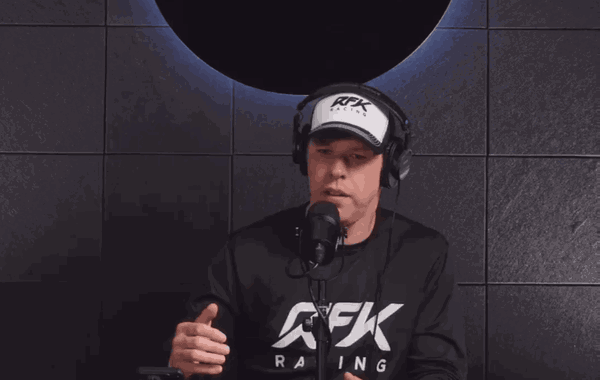

The Auto Club Speedway, once a crown jewel of NASCAR, hosted thrilling races until its last Cup Series event in 2023. Fans loved its wide lanes and high-speed battles, but plans to transform it into a short track hit a wall. NASCAR President Steve Phelps recently shared a tough update on the Hauler Talk podcast, saying the $300 million project is “on pause” due to rising costs and economic hurdles. “That market is an important one to us,” Phelps said, but admitted the numbers just aren’t adding up right now. It felt like a gut punch to fans who’ve been holding their breath for Fontana’s return.
Auto Club Speedway in Fontana, California, is a place where NASCAR dreams were born, where fans cheered, and where history was made. But for years now, it’s been silent, a ghost of its former glory. The track sits abandoned, leaving us all wondering if it’ll ever come back to life. Then, Brad Keselowski, a NASCAR champion and co-owner of RFK Racing with a heart for the sport’s future, stepped up with a spark of hope. He’s not just dreaming about Fontana’s revival—he’s pushing for it, and he’s got a plan.
ADVERTISEMENT
Article continues below this ad
Brad Keselowski talks about the role of Congress in Fontana’s revival
While Fontana waits, NASCAR’s been pouring love into other historic venues, Bowman Gray Stadium is stealing the show. After 54 years away, the Cup Series roared back for the 2025 Clash, and it was pure magic.
NASCAR.com described it as a “wild, unpredictable night” where 14,000 fans packed the stands, screaming as Chase Elliott battled through chaos to claim victory. The tight quarter-mile track delivered fender-banging action, with tempers flaring and cars scraping—exactly the raw, gritty racing we crave. And repeating the same feat at Fontana might require additional support.Brad Keselowski might have something to hold on to. Speaking with passion and purpose, he revealed he’s been working behind the scenes, meeting with lawmakers to make Fontana’s comeback real. He spoke about his endeavors in a post by RFK Racing on X, saying, “We go there, you know, we meet with Congress, a lot of different members in different congressional districts. I met with the lady, I think her name is Anita, whose district is the Fontana Speedway, and she wanted to know when we’re racing again in Fontana, and I told her, hopefully really soon, you can impact that. Absolutely.” He’s out there, meeting with people like Rep. Norma Torres (he might’ve meant her, not Anita), as she is the congressional representative for Fontana, which is in the 35th district in California. But his point stands, as Congress’s involvement is critical from a financial standpoint.
Will NASCAR return to Fontana…? 😳 pic.twitter.com/WWUovVmq4W
— RFK Racing (@RFKracing) April 11, 2025
What’s your perspective on:
Can Brad Keselowski's push for Fontana's revival overcome NASCAR's economic hurdles and political red tape?
Have an interesting take?
Brad Keselowski further added, “Because the Motorsports Caucus key initiative is to make it so that… not just NASCAR, but any station, but can invest in racetracks and does not take money from the community, but also does not get taxed for their investment on the facilities, which is really important. Because if you’re going to put like a hundred million into a facility… You don’t want to take that hit, plus the taxes on top of that. So it allows them to actually make critical investments in infrastructure that allows motorsports to survive and thrive for hopefully decades to come.”
Keselowski makes a great point here, emphasized by the words of NASCAR President Steve Phelps. On the Hauler Talk podcast, Steve Phelps laid it bare. He explained that construction costs have skyrocketed, and economic headwinds are making it tough to justify the investment, saying, “I’m still unsure.” Then he continued, “Would I like to build a new facility at Fontana? I would. It would be a short track because we don’t have room for anything else, frankly. Do I think creating a short track out there would be a cool thing for us? Yes.”
Fontana’s been missing from the NASCAR Cup Series since its final race there in February 2023, a bittersweet moment when
ADVERTISEMENT
Article continues below this ad
Dale Earnhardt Jr., a voice we all trust, didn’t sugarcoat it either. On his Dale Jr. Download podcast, he highlighted the importance of entities outside of NASCAR in bringing back the historic track. “Even if NASCAR wants to do it, they can’t get it done,” he said. He highlighted the steep costs and endless red tape that come with building in California, particularly for a racetrack or major sporting event. Earnhardt Jr. expressed skepticism about the project’s financial feasibility, describing it as a tough sell, “probably going to be a bigger pain in the a–”. Fontana’s revival seemed like a fading dream, slipping further away with every passing day.
ADVERTISEMENT
Article continues below this ad
The road ahead isn’t easy. NASCAR insiders still tease a Southern California return, but no one’s promising miracles. Yet, Keselowski’s fight gives us hope. If anyone can get the wheels turning, it’s a combined effort. So, let’s hold tight, NASCAR fans. Fontana’s story isn’t over yet, it might just be getting started again.
ADVERTISEMENT
ADVERTISEMENT
ADVERTISEMENT
ADVERTISEMENT


Can Brad Keselowski's push for Fontana's revival overcome NASCAR's economic hurdles and political red tape?